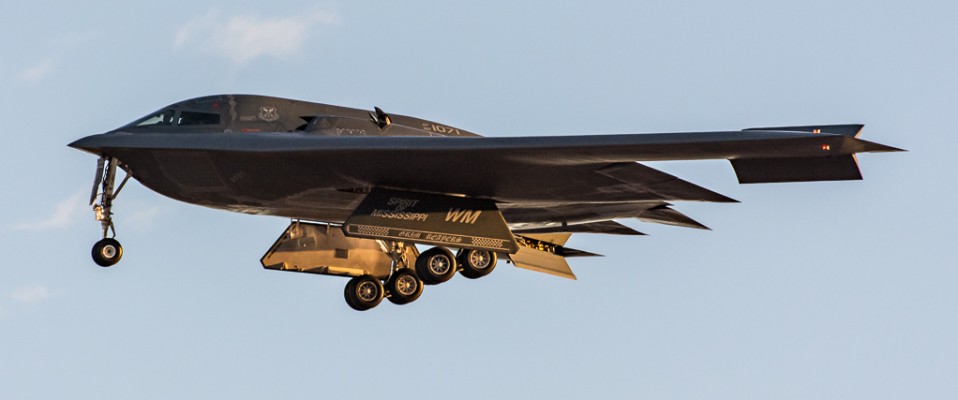Red Flag 15-1 : 40 Years of Realistic Combat Training
Article and Photos by Steven Valinski
February 11, 2015
With the sound of jet engines roaring, two B-2 Spirit bombers launch in the midday afternoon sun. Followed by three KC-135 Stratotankers and a Sentinel R1. Then comes a pair of Royal Australian Air Force (RAAF) C-130J Super Hercules followed by a wave of aggressor F-15 and F-16’s from the 64th Aggressor Squadron. Two EA-18G Growlers dart swiftly to 12,000 feet. Finally, comes a steady launch of F-15’s, F-16’s, F/A-18’s and Typhoons. These are the sounds, and sites, of a typical daytime launch during Red Flag 15-1.
Born from Project Red Baron II, which showed that a pilot’s chances for survival increased after their first ten combat missions, Red Flag today is a complex exercise designed to prepare a pilot by simulating those first ten missions, while integrating assets to defend against a wide variety of threats.
The most important benefit of the Red Flag exercises is integration. Integrating with dissimilar assets, integrating with other units, and integrating with allied countries to learn to work together towards a common goal. “The integration with the coalition forces often happens on operations for the first time, so it is critical we are prepared to participate in operations and, literally, speak the same tactical language and apply the same tactics, techniques, and procedures as our coalition partners” stated Wing Commander Darren Goldie, 37 Squadron, Royal Australian Air Force.
For Red Flag 15-1, two of the United States’ strongest coalition partners, Australia and the United Kingdom, who have worked closely together in recent conflicts, are participating. The Royal Australian Air Force brought two Lockheed Martin C-130J Super Hercules and a Lockheed AP-3C Orion, while the United Kingdom is participating with Boeing E-3D Sentry’s, Raytheon Sentinel R-1’s, and Eurofighter Typhoon FGR.4’s.
The latest Eurofighter Typhoons have been focusing on integration during the exercise. According to Flight Lt Andrew North, 1 Air Control Centre (1 ACC), RAF Scampton: “Their primary (role) is swing role, but we have had some air-to-air fights as well, especially with the integration between 4th and 5th generation, Raptors especially”. In addition to challenging the Typhoon’s multi-role capabilities, this will be the first operational test of its P1Eb upgrade. This upgrade was designed to enhance the Typhoon’s air-to-air and air-to-ground capability.
One of the most interesting aircraft participating in Red Flag 15-1 is the Northrop Grumman B-2 Spirit stealth bomber. Developed through top-secret programs in the 1980’s, the B-2 is capable of all-altitude attack missions up to 50,000 feet, with a range of more than 6,000 nautical miles without refueling. This unique, but menacing, looking aircraft is capable of conducting missions no other bomber in the world is capable of. Captain Brandon “Bloc” Bond, a B-2 pilot from Whiteman Air Force Base stated this about the B-2: “The stealth capability is well-known, but the payload, the range, and, really, the precision guided munitions that we can bring to the fight is something that, really, no other bomber in the world can do”.
Another interesting aircraft participating in Red Flag 15-1 is the Royal Air Force’s (RAF) Raytheon Sentinel R1. Based on the Bombardier Global Express, the Sentinel is a unique aircraft developed for airborne battlefield and ground surveillance. According to a RAF fact sheet on the Sentinel…using the aircraft’s powerful radar the mission crew can identify and track numerous targets over great distances, passing the information in near real time to friendly forces.
A Full list of Red Flag 15-1 participants can be found HERE.
Each day during Red Flag there are two launches. During each launch, roughly 50 fighters and 10 heavies launch. A total of 29 vuls will be flown for Red Flag 15-1 which is one week longer than the remaining Red Flag exercises this year. Red Flag 15-1 is the first of four Red Flag exercises in fiscal year 2015.
While the day launch and night launch may appear to be similar, there are distinct differences between the launches. One of these differences, for Red Flag 15-1, is the type of assets being used. The EP-3C’s, P-3’s, and E-3’s have been flown exclusively at night during Red Flag 15-1. The other difference is much less noticeable to the casual observer/enthusiast…“The target sets from a targeting perspective are largely going to remain the same (from day to night). What kind of threat picture is presented to the warfighter is normally a bit higher (tougher) at night. Mostly just because a lot of the junior flyers fly the day missions. The guys that come in at night are the more experienced flyers so we give them a tougher threat”, states 1st Lt. Paul Heins, the Department Targeting Chief of the 547th Intelligence Squadron.
Over the past forty years, the complexity of Red Flag exercise has progressed to include present-day threats. “We’re looking at a war that’s not conventional right now that we’re currently involved in. So we’re bridging the gap and figuring out how we can have an environment where we have near-peer threats in terms of radars and air threats integrated with our ISR (intelligence, surveillance, reconnaissance) assets,” stated 1st Lt. Paul Heins. The sophistication of these threats has also increased to include cyber and space threats, unmanned vehicles, and other modern-day realities.
Red Flag 15-1 began January 26, 2015 and is scheduled to conclude February 13, 2015. Red Flag is hosted by Nellis Air Force Base in Nevada, while missions take place over the Nevada Test and Training Range (NTTR).
Aviation Photography Digest would like to thank Msgt David W Miller Jr, A1C Joshua D Kleinholz, Airman 1st Class Jake E Carter, and the rest of the 99th Air Base Wing Public Affairs for their support during this exercise.







